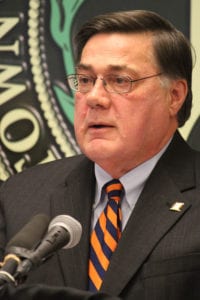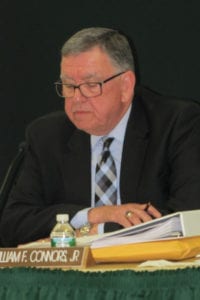In response to a proposed solar farm in Shoreham, members of the Brookhaven Town Board urge state legislators to not only stand with them in opposition, but grant them “a seat at the table” to have their voices heard and taken seriously.
Since it was first submitted last June, National Grid and NextEra Energy Resources’ proposal to build a large-scale solar energy facility on the wooded property that surrounds the abandoned Shoreham nuclear power plant, and clear 350 acres of the 800-acre land made up of cliffs, rolling hills and a variety of wildlife species, has sparked an outpouring of local opposition, from elected officials to environmentalists, civic associations, teachers and parents in the community.

Those against it share the belief that “renewable energy is important but not at the expense of another section of the environment.” As recently as Feb. 27, the Shoreham-Wading River school board voted unanimously against endorsing the project, despite a considerable financial offer from National Grid, which owns the Shoreham site, and NextEra.
According to the companies, the proposal, developed in response to a PSEG Long Island request to help New York meet Gov. Andrew Cuomo’s (D) renewable energy goals, would generate upwards of 72 megawatts of solar energy, provide power for more than 13,000 homes, and create between 125 and 175 construction jobs and millions of dollars in tax benefits.
It’s currently being considered by LIPA, which would purchase the electricity generated by the joint companies for a period of 20 years under the contract, and New York State.
Town Supervisor Ed Romaine (R), a leader in the charge against the solar farm, said he thinks the companies involved are making a mistake, and wants it to be known that Brookhaven is going to do everything it can to prevent it from happening and protect the environment.
In addition to the proposed site falling within Shoreham’s A-10 residential zoning code — the most restrictive in Brookhaven — which was put in place more than 25 years ago to specifically protect the “coastal forest preserve,” he said, the proposal directly violates Brookhaven’s solar code adopted last year that opposes cutting down trees or removing native forests to build solar farms or facilities.
“You can build [solar arrays] on clear land, on rooftops, and in parking lots, but you’re not cutting down trees,” Romaine said. “Brookhaven needs to stay green and we do not need to deforest the few uncut forests we have in this town.”

When Romaine and the rest of the town board first heard rumors of the solar farm plan more than a year ago, they dismissed it, confident local opposition and town zoning would be enough to prevent it from going anywhere.
However, the supervisor got word that National Grid and NextEra could get around the zoning restrictions and potentially strip away any of Brookhaven’s say in the matter under Article X of the Public Service Law — a provision allowing “an applicant seeking approval to site a major electric generating facility to obtain a final decision from the New York State Board on Electric Generation Siting and the Environment, waiving all local zoning requirements, if the Siting Board finds them to be burdensome in terms of technology and costs.”
The Siting Board is composed of five members appointed by the governor.
The town board sprang into action, writing and submitting a letter to nine state senators and assemblymen requesting that the law be amended to allow local municipalities to serve as mandatory parties to the proposed facility “application proceeding.”
“To allow the overriding of local zoning without allowing the local community a significant voice in these proceedings is wrong,” reads the end of the letter, which was signed by Romaine, Councilwoman Valerie Cartright (D-Port Jefferson Station), Councilwoman Jane Bonner (C-Rocky Point), Councilman Kevin LaValle (R-Selden), Councilman Michael Loguercio (R-Ridge), Councilman Neil Foley (R-Blue Point) and Councilman Daniel Panico (R-Center Moriches).
“We understand there’s a need for Article X and we’re not saying you can’t decide against us, but we just feel the locality should have a seat at the table, which would give us a voice,” Romaine said, admitting he decided to write to the legislature to be on the safe side, not knowing if the proposal will get that far. “Right now, we have no voice.”

According to a fact sheet provided by National Grid and NextEra, a poll to determine the attitudes of the residents of the Town of Brookhaven was commissioned, asking what they would like to see developed on the Shoreham property — “they chose ‘solar energy project’ above any other use,” it said. When residents were given information about the solar farm project, the sheet stated “level of support grew to 75 percent.”
Conversely, the proposal is an environmental nightmare as far as Sid Bail, president of the Wading River Civic Association, is concerned.
“This is just a horrible use of the land,” he said. “It’s not just cutting the trees with the thought that ‘They’ll grow back in 50 years,’ it’s the hills, the gullies, the wildlife, the plants and the fauna that would have to be destroyed. I can see why the owners of the property, National Grid, would like to do this, they can make a bundle of money from it … however the idea of deforesting several hundred acres of very special forest land in order to achieve a worthwhile goal isn’t a good trade-off.”
Assemblyman Steve Englebright (D-Setauket), chairman of the Committee on Environmental Conservation, deemed the proposal a bad idea, stating the Shoreham site is worthy of being preserved as part of our natural history.
“This is a native forest in essentially pristine condition … it’s a museum piece of natural land,” Englebright said. “I am the original New York State legislator who sponsored what are now the laws that enabled solar energy to begin to take off. I’m a pro-solar, pro-renewable energy person … [but] it was never my intent to see environmental atrocities committed in the name of renewable energy. I’m offended, as the father of solar energy in this state, that they are attempting to so thoroughly abuse the premise of what solar is meant to be.”



















